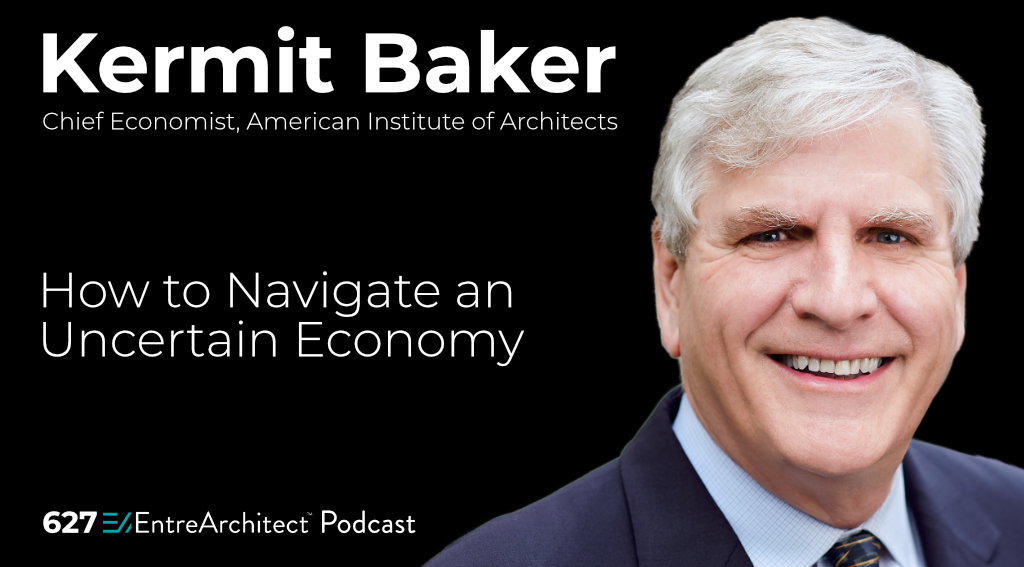
When you’ve been in practice long enough, you realize the economy is not something that happens to “other people.” Every shift touches our firms. Sometimes it’s a flood of inquiries we can barely handle. Other times, it’s silence on the phone and emails that take weeks to be answered. Most of us are feeling the weight of uncertainty right now. Some firms are busy but anxious about what’s next. Others are already seeing thin pipelines.
That’s why I invited Kermit Baker, Chief Economist at the American Institute of Architects and creator of the Architecture Billings Index, to join me on EA627. Kermit has been tracking the architecture profession for decades, and he knows how to interpret the signals. But more importantly for us, he knows what small firm architects can actually do when the ground under our feet doesn’t feel stable.
Here are the lessons and practices that stood out from our conversation. I believe they form a practical playbook for architects who want to navigate uncertainty and still build strong, resilient firms.
Accept That Every Cycle Is Different
One of the first reminders from Kermit was that no two downturns behave the same way. The Great Recession was brutal on our profession. The pandemic created a temporary collapse that rebounded in surprising ways. Now we are in something else entirely: a long, mild slowdown with mixed signals across regions and sectors.
What this means is simple: we cannot dust off the same old plan and hope it works. Each cycle demands fresh eyes. As leaders of small firms, our advantage is agility. We can read the signals, adjust quickly, and make changes without the bureaucracy of large practices. But only if we commit to staying informed.
Think about it: if you had applied your 2009 playbook during 2020, you would have shut down just when demand was about to surge again. And if you’re treating 2025 like 2021, you’ll miss the nuances that are shaping today’s construction environment. The first step is to accept that this is a new moment, requiring a new response.
Build an Information Habit
The enemy of smart decision-making is uncertainty. The antidote is not blind optimism, it’s information. Kermit emphasized that small firms can win by developing a rhythm of monitoring what matters.
I recommend this cadence:
- Weekly: Spend 30 minutes scanning your local economy. Read a regional business journal, a local news source, and a construction or housing update. Capture three signals that matter to your market. For example: Has a major employer announced layoffs or expansion? Has your town planning board approved a large new development? Are local banks tightening lending requirements?
- Monthly: Review internal leading indicators. Count inquiries, calculate hit rates on proposals, and track net new contracts. Don’t chase single-month swings — look for patterns. If your inquiries have dropped for three months in a row, that is more meaningful than one slow week.
- Quarterly: Pressure-test your backlog. Run the numbers 60 to 120 days ahead. If two projects slipped by a month, would you have enough cash and capacity? Better to know now than to be surprised later.
This discipline turns vague worry into manageable risk. And once you have that information rhythm, you can make better decisions about staffing, marketing, and cash flow.
Protect and Prioritize Your Backlog
For small firms, backlog is survival. Larger firms often have eight to ten months of committed work. Smaller practices often live with three to four. That makes us more vulnerable when projects slip.
Kermit’s research shows that backlog is shrinking across the profession. For us, that means we must actively manage it. Clarify scope early, set short proposal acceptance deadlines, and always know your minimum safe backlog. If you drop below it, step up marketing immediately and prioritize quick-start projects to stabilize cash.
A practical exercise: write down your current backlog in weeks. Then ask yourself, “How many weeks of work do I need to feel safe?” That number is your minimum safe backlog. Post it on your office wall. Every week, update where you stand. When you fall below that number, it’s your trigger to push harder on outreach.
Lead Clients with Better Conversations
When clients are nervous, silence kills projects. In uncertain times, architects need to increase the frequency of check-ins. Every conversation should answer three questions:
- What are you worried about right now?
- What information can I provide to reduce that worry?
- What decision can we move forward together this week?
Bring specific updates on material costs, contractor availability, or permitting. Don’t wait for clients to ask. When you deliver clarity, you become a trusted partner instead of just another consultant waiting for instructions.
For example, if you know that lumber prices are steadying while concrete remains volatile, share that insight and explain how it might affect your design decisions. Clients appreciate being guided through uncertainty. It builds trust, and trust keeps projects alive.
Use the ABI the Right Way
The Architecture Billings Index (ABI) is one of the most visible signals in our profession. Too many architects glance at the headline number without connecting it to their firm. Kermit reminded me that the ABI is most powerful when paired with your own indicators.
When the ABI rises and your billings rise too, you know the market is lifting broadly. If your billings rise while ABI falls, you may have a positioning advantage. When ABI softens, it’s time to tighten proposals, protect fees, and sharpen marketing. It’s not about predicting the future — it’s about interpreting your place within the cycle.
This is where small firm agility comes into play again. We don’t need to know everything about the national economy. We need to know enough to understand whether our successes are part of a larger wave or the result of our unique positioning.
Design with Materials and Labor in Mind
Uncertainty today is not only about money. It’s about availability. Materials and labor drive project risk. Kermit encouraged us to understand the categories that dominate each project type. For a wood-frame home, track lumber. For commercial interiors, track steel, glass, and finish packages.
Bring that intelligence to your clients. Show them cost and availability tradeoffs in schematic design, not after bids. Provide A, B, and C options that preserve vision while flexing around risk. This is not value engineering — it’s proactive leadership.
Think about the last time a client panicked over a price increase. What if you had been able to say, “We anticipated this possibility. Here are two alternatives that maintain the spirit of your design without the same risk.” That’s the kind of leadership that sets architects apart.
Adjust Schedules to Reality
Builders are adding time to projects because they don’t know if they’ll have crews when needed. If your construction administration assumptions are built on pre-pandemic durations, you’re underpricing your services. Bake current realities into your scope and fees. Don’t argue for old schedules — plan for the world we’re in.
This doesn’t just protect your profit. It protects your relationships. Clients will be frustrated if they expect a 12-month build and it stretches to 16. But if you’ve prepared them for a realistic timeline, you remain their guide rather than the bearer of bad news.
Special Notes for Residential Architects
Many EntreArchitect members lead residential practices. Kermit sees a split picture. Remodeling is holding strong, particularly kitchens, baths, and additions. Luxury and custom homes are healthier than mid-market because cash buyers are less sensitive to interest rates. Entry-level housing is softest.
The message is to go where the demand lives. Target your services and marketing toward the segments showing momentum. Don’t waste energy chasing sectors that are stalled.
For example, if you’ve been focused on new starter homes, consider whether your expertise could be applied to high-end renovations instead. Or if you’ve been doing speculative multifamily, look at whether owner-occupied additions are growing in your region. Sometimes a slight pivot can make the difference between struggle and stability.
The Weekly Checklist for Firm Health
Here’s a simple practice you might adopt from my conversation with Kermit:
- Count new inquiries and proposals.
- Update backlog burn rate by project phase.
- Request current pricing on top three material categories.
- Ask two builders about labor changes.
- Clip three local economic signals that matter to your clients.
Do it every week in 45 minutes. Consistency is everything.
Over time, this practice will give you a personal dashboard that’s far more valuable than any headline report. You’ll begin to see patterns earlier, and you’ll feel more confident in your decisions.
Clarity and Positioning Win
When I asked Kermit for one action every small firm can take in uncertain times, his advice was to sharpen positioning. Be crystal clear about who you serve and the unique advantage you bring. That might be deep local knowledge, or specialized expertise in a niche problem. Either way, clarity cuts through noise and helps clients choose you with confidence.
It’s tempting in uncertain times to say yes to everything. But that can dilute your brand and stretch your resources. Ironically, the firms that stay most focused often do the best. They know their client, they know their strengths, and they communicate both clearly.
Moving Forward with Confidence
Uncertainty is uncomfortable, but it’s also an opportunity. Small firms can adjust faster than large ones. We can build closer relationships with clients. We can bring leadership that reduces risk.
If you want to dive deeper into how to read the signals, how to use the ABI alongside your firm’s numbers, and how to turn uncertainty into practical steps, I encourage you to listen to EA627 with Kermit Baker at https://entrearchitect.com/627.
Bring it to your next team meeting. Choose one idea that resonates and implement it within a week. That’s how small firm architects move from uncertainty to strength.

Thanks for the article, Mark. Practical and encouraging advice that helps small architects stay steady and adapt during economic uncertainty.